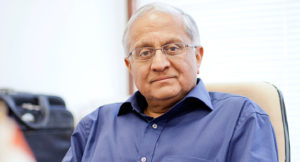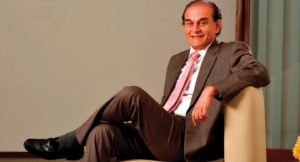
He built the bank around five key brand pillars – growth, trust, human capital, technology, along with transparency and responsible banking. Since incorporation, the bank has grown well and has maintained a consistent net interest margin between 2.7 per cent and 3.2 per cent over the past five years through periods of rising and declining interest rates. With over 350 branches and 600 ATMs throughout the country, it has reported a net interest income of Rs. 1,616 crore and net profit of Rs. 977 crore for the financial year ending March 2012. In a span of nine years, the bank has received significant national and global recognition and accolades. It was recognised as India’s No. 1 new private sector bank at the Financial Express Best Banks Awards 2011, and the fastest growing bank in the Business Today-KPMG Best Banks Annual Survey 2008, 2009 and 2010. YES Bank received the Rank 1 sustainable bank of the year (Asia/Pacific) award at the FT/IFC Sustainable Finance Awards 2011, London, and in 2008, was ranked the Emerging Markets Sustainable Bank of the Year.
Kapoor believes that entrepreneurs go through a lifecycle during which one has to redefine the original vision with which they started out to build their company. “There have to be orbit changing interventions when one goes through a lifecycle of entrepreneurship,” he says. When he started YES Bank, its version 1.0 (named in retrospect today), covering a period from its incorporation to 2010, was to set up a small bank with innovative strategies to survive among the much established and powerful players while maintaining a low cost base. Kapoor then had to redefine the bank’s original goal, and shifted the bank’s journey to the next gear and YES Bank is currently going though its version 2.0 (read more about version 2.0 in pg.26) growth phase defined by the need to scale up its operations to meet the opportunities seen in the space.
Kapoor shares with us the 10 things he did right during this initial period at YES Bank, which form the strong foundation on which the bank will continue its growth journey.
Fulfilling a dream
“It all started with a dream,” recalls Kapoor. In 1979, when he was a summer trainee (while studying at Rutgers’ University) in New Jersey, U.S., he used to go to New York City often and was awestruck by the big banks and its buildings towering over the skyline. He wanted something like that in India. “I think the dream was born there. Those were, of course, the early days,” he adds. As he progressed in his work life, starting as a corporate banker in Bank of America, then an investment banker in ANZ Grindlays and later, as an entrepreneur in Rabo India Finance (which was on a build, operate, own and transfer basis) in partnership with Rabobank in India, he felt that he would eventually get to build a bank of his own. When he got the right opportunity, he evangelised his dream to a group of people, thus evolving a common platform for sharing a dream and making it a collective proposition and YES Bank was born in 2004.
“The art of banking is the management of risk. You run a risk if you do something, but you run a bigger risk if you don’t do anything.“
![]()
This was also the time when a new category of players called the professional entrepreneurs evolved. “This is an oft used term now, but back then it was not common to read or discuss professional entrepreneurship,” says Kapoor. The term perfectly described people like Kapoor, who got an opportunity to embark on an Indian banking venture, after serving as an executive in a couple of foreign banks for 18 years. “The concept of professional entrepreneurship struck the right chord and it helped build professional chemistry around this point,” recalls Kapoor.
Create ownership
His team members were evolving as owners-managers-partners in this shared proposition. “The top management realised that this was almost a once in a lifetime opportunity to build a brand new bank in modern India at a time when the Indian economy was picking up,” says Kapoor. India was entering a five-year economic boom between 2003 and 2008 then. And Kapoor created an ownership structure amongst his top executives (who were mostly ex-colleagues or people recruited from large private and foreign banks in India) in the form of a good salary structure, bonus and ownership stock options. He had the long term commitment of his people by granting stock options, which was motivating his team to conduct themselves as owner-manager-partners. “It was the best-of-breed combination, consisting of people with different skill sets in different areas which helped in setting up the plumbing lines of the bank,” says Kapoor. The systems, processes, procedures and controls are a very important aspect of a bank’s architecture. And this has kept the bank in good stead even as it is scaling into its version 2.0.
It’s all in a name
“What I didn’t realise then, but now I do in retrospect, is the simplicity, positivity and the service proposition that the brand YES signifies,” says Kapoor. He believes that the banks’ differentiation and ingenuity begins with its services and the trust it creates. Above all, the name YES implies this fundamental goal of being a service-oriented institution. This apart, the idea was to create and convey an institutional image with a name that has pan India recognition as a new age Indian bank. “Most of these points synergise in the name itself and when we did our qualitative research, the name YES resonated very well,” he says.
Governance and transparency
Strong governance and transparency in the business model, right from the beginning, has built confidence with the team, in the market place and with the regulators. In fact, from its inception, YES Bank has had a strong governing board, with more than 50 per cent being independent directors. This was just around the time (in early 2004) when the Ganguly Committee recommendations to the Reserve Bank of India (RBI) and Clause 49 from SEBI (Securities and Exchange Board of India) had just come into effect stating such a proposal besides others. “We were way ahead when it came to appointing our independent directors and we have maintained it that way so far,” says Kapoor. At present, the bank has over 70 per cent independent directors. Independent directors are expected to be independent from the management and act as the trustees of shareholders. This means that they have to be fully aware of and question the conduct of the organisation on relevant issues.

Institutionalise the bank
“A very good validation of our business and financial model was the fact that instead of getting granular investors, we chose to institutionalise the bank from the very inception,” says Kapoor. He got the AAA-rated Rabobank to take a 20 per cent stake at par value (it has since then sold its stake in 2010 and 2012) and at a very nominal premium, he brought in three private equity investors– CVC Capital Partners, a division of Citibank (10 per cent stake), AIF Capital from Hong Kong (7.5 per cent stake), ChrysCapital (India and the U.S. for 7.5 per cent stake). “All three PE firms monetised their investment in 2007 / 2008 with a gain of 15 per cent to 17 per cent,” shares Kapoor. Even though the bank was founded by Kapoor and his partner, the late Ashok Kapur (the non-executive chairman), who were both professional entrepreneurs, they actually went on to evolve an institutional organisation. The two partners gave 45 per cent stake away and of their remaining 55 per cent, three per cent was given to top six managers who joined them at inception. The institutionalisation of the bank started right then.
Outsource the technology
The bank took the first major innovative decision to outsource its entire technology requirements to Wipro Infotech, an IT services organisation with presence in India, APAC and Middle East. Gartner India (its strategic advisor to develop a comprehensive IT strategy) and YES Bank’s in-house innovation team (business management, innovation and strategy team was conceived right at its inception) along with the stakeholders collaborated to work on a first-of-its-kind outsourcing solution for a bank in India. “While Wipro Infotech was doing similar work overseas, they got their first outsourcing Banking contract in India from us and that partnership is almost 7.5 years old today,” shares Kapoor. The bank has outsourced the core IT infrastructure and hardware, networking, managing the data centre and backup support for disaster recovery, hardware procurement and servicing of network. “After us, a number of other private and public sector banks replicated this model,” says Kapoor. This outsourcing partnership has resulted in cost savings of almost 30 per cent for the bank, and has enabled it to focus fully on its core business of banking and strategic initiatives.
Building excellence in service delivery is critical for Kapoor and his team, and the bank partnered with leading edge technology providers to do so. It was the first bank to use treasury trading solution from a French firm, Murex, in India and has first-of-its-kind service technologies like Money Monitors, which aggregates all the financial information. In 2006, YES Bank was invited by Intel Technologies to Shanghai to visit a mock-up of the ‘bank branch of the future’ powered by Intel’s technologies. After the visit, the bank partnered with Intel to put up a live, proof-of-concept bank branch of the future in India. Spread over 15,000 square feet, the branch is located in South Extension in New Delhi and is called the YES-Intel Global Innovation Center. Intel launched its first WiFi-enabled bank branching network from the location. It has also partnered with Nokia for the global launch of mobile money transfer.

Driven by knowledge
Yes Bank has a knowledge-driven culture. A critical differentiator in its business acquisition and risk management strategy has been the knowledge banking platform (identifying specific growth sectors and developing customised solutions for industry verticals) that was created through sharp segmentation of industries, of geographic spread and size. “Our relationship managers, product managers and risk managers have a diagnostic and prescriptive approach to their clients in a particular industry,” shares Kapoor. This approach was very much in sync with India’s economic condition then as the country was evolving and taking centre stage as the knowledge economy of the world. “While other banks do have specialised banking in small parts, it is not embedded in the genetics of their bank,” says Kapoor. Historically, traditional banks have a universal banking approach. “Be it a steel company, healthcare, or hospitality, they probably have the same person taking care of the sectors. In Yes Bank, if it’s agribanking, we hire agricultural management graduates; in healthcare, we get people from the healthcare industry,” Kapoor points out. They work with the general management professionals to multiply the knowledge pool. The bank is now deepening and widening this strategy and, moving forward, Kapoor expects this strategy to become a bigger differentiator as the bank scales.
Make it public
The really bold decision of the bank, apart from naming it YES, was to come out with an initial public offering (IPO) within nine months of its inception. “We had to launch the bank,” states Kapoor. So, to do it most effectively, he wanted to build the best internal and external confidence, implement the highest levels of governance, transparency and accountability, and also in a way make it responsible, literally, every day and definitely every quarter, to the public. After all, a bank by very definition is a public trust institution. And, according to Kapoor, an IPO does all of this. It launches a bank, gets governance, builds the report card, shows people that there is some wealth that is being created due to hard work in the inception stages and there is a trajectory to all of this. The bank came out with an IPO of 70 million shares in July 2005 raising Rs. 315 crore of capital at a price of Rs. 45 per share. It got oversubscribed 30 times.
Be responsible, socially
“One other thing which has been mission critical is as we were born in 2004, we conceived our corporate social responsibility strategy both at a corporate level (through Responsible Banking) and at retail level (via YES Community Banking),” says Kapoor. Responsible Banking has an objective of developing innovative business solutions to social and environmental problems. It comprises of three business verticals – agribusiness, rural and social banking; microfinance and sustainable investment banking, which addresses sustainable ventures such as social, alternative energy and environment.
In 2008, the bank launched YES Community, a Responsible Banking initiative across its retail branches nationally. YES Bank has won many accolades as a sustainable bank in India in 2012, 2011 and 2008. Kapoor has received the Godfrey Phillips Bravery ‘National Special Social Award’ for actively driving the vision of Responsible Banking.

Thin, lean and agile
Simple as it may sound, a thin, lean and agile team with good management frameworks has been instrumental in manoeuvring YES Bank to where it is today. This has been a very important factor in building the agility, productivity and cost competitiveness in the institution. “I even presented cheetah desktop statues to 500 members of my team so that they think and believe in agility and seize the opportunity that comes along their way. In difficult times, we need well-defined management teams with clear focus, vision and strategies,” says Kapoor.
THE TEN THINGS
- When he got the right opportunity, he evangelised his dream to a group of people, thus evolving a common platform for sharing a dream and making it a collective proposition.
- His people were evolving as owners-managers-partners in this shared proposition. And were setting up efficient systems, processes, procedures and controls.
- The simplicity, positivity and the service proposition that the brand YES signifies.
- Strong governance and transparency in the business model, right from the beginning, has built confidence with the team, in the market place and with the regulators.
- Institutionalising the bank from its very inception.
- The bank took the first major innovative decision to outsource its entire technology requirements to a third party resulting in a long term cost advantage.
- Creating a knowledge banking platform through sharp segmentation of industries, of geographic spread and size.
- An initial public offering (IPO) within nine months of its inception for greater accountability and transparency.
- Conceiving its corporate social responsibility strategy both at corporate level (Responsible Banking) and at retail level (YES Community banking) at inception.
- A thin, lean and agile team with effective management frameworks.
What was Dr. Rana Kapoor looking for when setting up his management team?
I was looking for owner-manager-partners and was fortunate to find such people. It’s not like we have had a one-way ride. There have been bumps along the way during 2008 – 09 and in the last 12 – 18 months, and that is when the mettle of the team and weather-proofing of the organisation gets tested. Bank is a macroeconomic player and even if you do everything to insulate it, you are still exposed to the macro economic conditions. Hence, a lot depends on the people who tackle and solve the problems. There are three things in management that are very important – having strong grasping skills, making decisions – be it right or wrong, and having good problem solving skills. We will always have problems in any entrepreneurial venture but the ability to grasp the situation, make a decision and solve the problem is very important. These are qualities that are embedded in our top and senior management team.

His management style
I am a very hands-on entrepreneur. I spend 50 per cent of my time on human resources and the rest on the management of risk, growth, systems, sales and marketing. I get into details very often, as banking is about detail and not only about retail. Building a bank can take anywhere between 10 to 20 years and to do it, there is no substitute for hard work. We have this philosophy of ‘the harder you work, the luckier you get’.
Advice to budding entrepreneurs
Get a good management team and ensure that they are part of an owner, manager and partner establishment. It does help to have clarity in your vision and strategy. Vision without action is like a daydreaming. Action without vision is like a nightmare. I believe that having a good vision and strategy, and putting in a lot of action by example will help. In any entrepreneurial venture, have a clear risk and management framework; visualise, strategise and actualise. Make decisions right or wrong and try to solve problems promptly. That is the key to sustainable leadership.
RANA KAPOOR’S LIGHTER SIDE
Who inspires you?
I am inspired by the six ladies in my family – mother, sister, wife and three daughters.
Your exercise routine:
I am on the treadmill at least four to five times a week. I stopped yoga and golf over the last couple of years.
How do you unwind :
I read up on domestic and global economics and politics, other books and watch TV. I read a lot of magazines and newspapers.
Your favourite holiday destination : Shimla and Italy
Favourite Books : “A Whole New Mind” by Daniel H. Pink
Your role model : Bill Clinton and Ratan Tata
Luckiest thing that has happened to you:
Evangelising a dream, being able to crystallise an idea and convert it into action. Idea and action have proven lucky for me. When I focus on an idea, the first thing I think is how to actualise it.
HOW DID YES BANK TIDE THROUGH THE CRISIS IN 2008 – 09:
It was literally shock treatment when the global crisis descended as fast as it did. After the initial shock of one or two months, we decided to overcome the crisis by adopting proactive strategies. Apart from tightening and strengthening risk management, we made contrarian decisions to use that opportunity, after we got our house in order, to get into retail expansion. We started hiring people. We got very good people especially at middle and junior levels. We started building a brand and were able to demonstrate confidence internally and externally. The markets saw that the bank was confident and overcoming challenges. Investment in the brand happened meaningfully after a long gap (after the IPO in 2005). We also acquired more customers at the top end, as a lot of customers who were somewhat hesitant to deal with a small bank at that particular time saw that the bank was demonstrating confidence and they started doing business with us. Top groups like the Tata group, in India became our clients in 2009 – 10. And post the crisis, we were able to prove that we are serious and deeply committed to them.





